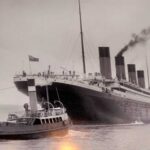A Lot Of People Are Only Just Finding Out Where The Titanic Actually Sank
The post A Lot Of People Are Only Just Finding Out Where The Titanic Actually Sank appeared first on Healthy Holistic Living.
In the vast and mysterious expanse of our oceans lies a story that has captivated the imagination of many for over a century. The Titanic once heralded as the largest and most unsinkable ocean liner in the world, embarked on its maiden voyage from Southampton, UK, to New York, USA, with dreams of transatlantic triumph. Yet, this monumental journey was cut tragically short. Four days into crossing the Atlantic, an iceberg caused the Titanic to meet its untimely demise, sinking into the cold abyss and claiming over 1,500 lives. This event, etched in history, serves as a humbling reminder of nature’s unpredictable power and the limits of human ingenuity.
Recently, the Titanic has resurfaced in the public consciousness, not through tales of its past splendor or the tragic night it sank, but through a modern-day exploration that ended in sorrow. The OceanGate Titan submersible, on a mission to visit the shipwreck, vanished, leading to the loss of all five people aboard. This incident has not only rekindled interest in the Titanic’s story but has also shed light on misconceptions about its final resting place. As we delve into the details of its journey, the disaster, and the aftermath, we uncover a narrative filled with intrigue, tragedy, and a continuous quest for understanding amidst the unfathomable depths of the sea.
The Journey and the Iceberg: A Tale of Hubris and Tragedy
The RMS Titanic, boasting unparalleled size and luxury, set sail on April 10, 1912, from Southampton, destined for New York. It was a symbol of human achievement, designed to be unsinkable and equipped with advanced safety features of the time. The voyage began with great fanfare, as passengers from diverse backgrounds, including some of the wealthiest individuals in the world, embarked on what was promised to be a historic crossing. The ship’s route took it from Southampton to Cherbourg, France, then to Queenstown (now Cobh), Ireland, before heading across the vast Atlantic Ocean.
The Titanic’s journey was a marvel of the modern industrial age, promising speed and safety. However, the North Atlantic was notorious for icebergs, especially in the early spring. Despite the dangers, the ship pressed on at high speed, under the command of Captain Edward John Smith. The belief in the Titanic’s invincibility was perhaps its greatest vulnerability. The ship was equipped with Marconi wireless telegraphy, an innovative technology that received iceberg warnings from other ships. Yet, the fatal collision with an iceberg, 640 kilometers off Newfoundland, came as a devastating surprise on the night of April 14. The impact was catastrophic, breaching the Titanic’s supposedly impregnable hull and allowing frigid water to flood in. Panic ensued as passengers and crew faced the grim reality of the situation.
The Titanic, divided into sixteen watertight compartments, was designed to float with up to four of these compartments flooded. However, the iceberg’s blow had compromised five compartments, sealing the ship’s fate. As the Titanic sank, the inadequacy of lifeboats, a tragic oversight stemming from outdated safety regulations, became painfully evident. The chaos of the evacuation, coupled with the ship’s band playing in an attempt to maintain calm, remains one of the most poignant images of the disaster. Titanic’s story not only underscores the technological hubris of its era but also highlights the human element of the tragedy. The hopes and dreams of those aboard, the acts of bravery and sacrifice, and the stark realization of the Titanic’s vulnerability, all contribute to the enduring legacy of the ship’s maiden voyage.
The Ill-Fated Night: Disaster Strikes
As the Titanic sailed through the icy waters of the North Atlantic, the night of April 14, 1912, would become a moment frozen in time, marking one of the deadliest maritime disasters in history. The collision with the iceberg was not a dramatic crash but a fatal graze that allowed sea water to flood the ship at a deadly rate. The ship’s design, revolutionary for its time, featured watertight compartments intended to make it unsinkable. Yet, this innovation was rendered moot as water spilled from one compartment to the next, sealing the fate of the Titanic and those aboard. The aftermath of the collision was chaos wrapped in disbelief. Many passengers and crew members initially did not comprehend the gravity of the situation, given the ship’s reputation as unsinkable.
Captain Smith, realizing the dire circumstances, ordered the lifeboats to be prepared, but the reality was grim: there were not enough lifeboats for everyone on board, a tragic oversight based on outdated safety standards and misplaced confidence in the ship’s design. As the Titanic began its descent into the icy waters, the evacuation process was marked by confusion and panic. Women and children were given priority, but the lack of sufficient lifeboats and the chaotic evacuation process led to heartbreaking decisions and acts of heroism. The ship’s band played on, an attempt to provide calm amidst the unfolding tragedy, a poignant symbol of human dignity in the face of disaster. In the cold Atlantic, the inadequacy of the response to the disaster became tragically clear. Lifeboats were launched partially filled due to misunderstandings and disbelief, a testament to the chaos and confusion of the evacuation.
The temperature of the water was lethally cold, leading to hypothermia and death within minutes for those who ended up in the ocean. As the Titanic finally broke apart and sank, the scale of the tragedy was immense. Over 1,500 people lost their lives, a stark reminder of the human cost of arrogance and the limitations of technology. The disaster was not just a physical sinking but a profound human tragedy that would echo through the ages, a somber lesson in humility, the fragility of life, and the indomitable spirit of those who faced their final moments with courage.
The Aftermath: A World Shocked and Changed
The Titanic disaster reverberated around the globe, shattering the era’s blind trust in technological advancement and ushering in a period of soul-searching and regulatory overhaul. The loss of the “unsinkable” ship not only dominated headlines worldwide but also prompted a reevaluation of maritime safety standards. The inquiries that followed in the United States and the United Kingdom laid bare the inadequacies that had contributed to the tragedy, such as the insufficient number of lifeboats and the lack of comprehensive iceberg monitoring systems.
In response to the catastrophe, significant maritime safety reforms were implemented. These included the adoption of new regulations requiring ships to carry enough lifeboats for all passengers and crew, the establishment of continuous radio watch, and the formation of the International Ice Patrol to monitor the North Atlantic for icebergs. These changes marked a pivotal moment in maritime history, where safety took precedence over aesthetics or economics, ensuring that the legacy of the Titanic would lead to safer seas for future generations.
The sinking of the Titanic remains a powerful reminder of human fallibility and the limits of technological mastery over nature. It has become a symbol of the need for humility, the importance of preparedness, and the value of human life. Memorials across the world stand testament to the lives lost and serve as a call to remember the lessons learned from one of the most poignant tragedies of the 20th century.
Unraveling Misconceptions: The Titanic’s Final Resting Place
One of the most enduring mysteries of the Titanic disaster has been its final resting place. For decades, the exact location of the Titanic’s wreckage eluded explorers, fueling myths and speculations about the depths to which it sank. It wasn’t until 1985, more than 70 years after the tragedy, that the wreck was finally discovered, lying about 3,800 meters (approximately 12,500 feet) below the surface of the North Atlantic Ocean. This discovery not only provided closure for many but also challenged long-held misconceptions about the ship’s demise.
The Titanic’s wreckage revealed that the ship had broken into two main pieces, which lay approximately 790 meters (about 2,600 feet) apart on the ocean floor. This contradicted earlier beliefs that the Titanic had sunk intact. The exploration of the wreck has offered invaluable insights into the final moments of the ship, shedding light on the catastrophic damage inflicted by the iceberg and the ship’s subsequent breakup. These findings have led to a better understanding of the disaster and have helped demystify many aspects of the Titanic’s sinking.
Moreover, the location of the Titanic, far from where many had imagined, underscored the vastness and unpredictability of the ocean. The discovery also reignited public interest in the Titanic, leading to numerous expeditions that have since mapped the site in detail and recovered thousands of artifacts. These artifacts, ranging from personal belongings to pieces of the ship itself, serve as poignant reminders of the human aspect of the tragedy. They tell stories of the lives interrupted by the disaster and offer a glimpse into the world of early 20th-century sea travel. The ongoing exploration and study of the Titanic wreck continue to captivate and educate, ensuring that the legacy of the ship and those associated with it lives on.
Lessons Learned: The Legacy of the Titanic in Maritime Safety
The Titanic disaster, while one of the most tragic maritime events in history, served as a catalyst for sweeping changes in maritime safety regulations and practices. The lessons learned from the sinking have had a lasting impact on how safety is managed at sea, leading to reforms that have undoubtedly saved countless lives in the years since. This section explores the critical safety improvements and the enduring legacy of the Titanic in promoting safer maritime travel.
Lifeboat Requirements: In the immediate aftermath of the Titanic disaster, international maritime law was amended to require that ships carry enough lifeboats for all passengers and crew members. This was a direct response to the Titanic’s insufficient lifeboat capacity, which contributed significantly to the high death toll.
Ice Patrols: The establishment of the International Ice Patrol, under the auspices of the United States Coast Guard, was another significant outcome. This organization monitors iceberg dangers in the North Atlantic, providing crucial information to prevent similar tragedies. The Ice Patrol’s work has made the waters where the Titanic sank among the safest maritime routes in the world.
Radio Communications: The Titanic disaster highlighted the importance of continuous radio communications. Regulations were introduced to ensure that ships maintain a 24-hour radio watch, enabling them to receive and respond to distress signals at any time. This change has been fundamental in improving the speed and effectiveness of maritime rescue operations.
Safety Drills: The introduction of mandatory safety drills for passengers and crew ensures that everyone on board is familiar with evacuation procedures. This practice, which was not standard at the time of the Titanic, enhances the chances of survival in the event of a maritime disaster.
SOLAS Convention: Perhaps the most significant legacy of the Titanic is the International Convention for the Safety of Life at Sea (SOLAS), first convened in 1914. SOLAS has been updated numerous times to incorporate the latest safety standards and technologies, serving as the most important international treaty concerning the safety of merchant ships.
The Titanic disaster’s impact on maritime safety is a powerful testament to the ability of humanity to learn from its mistakes. While the tragedy itself remains a somber reminder of the cost of oversight and complacency, the reforms it inspired have transformed maritime travel, making it safer for everyone. The legacy of the Titanic continues to influence modern safety standards, ensuring that the memory of those lost serves as a perpetual call to vigilance and improvement in maritime safety.
Embracing the Lessons: The Titanic’s Legacy
The Titanic’s story, from its ill-fated voyage to the discovery of its wreckage, continues to fascinate and educate. It serves as a stark reminder of the limits of human engineering and the need for respect and caution in the face of nature’s unpredictability. The tragedy has also highlighted the importance of safety regulations and preparedness in the maritime industry, lessons that have undoubtedly saved countless lives in the years since. The Titanic’s legacy is not just one of tragedy but also of learning and improvement, showcasing humanity’s ability to grow from its mistakes and to implement changes that prioritize safety and human life above all else.
As we look back on the Titanic over a century later, its story remains a powerful testament to human ambition, resilience, and vulnerability. It encourages a continuous pursuit of knowledge and understanding, not just of the technical aspects of maritime safety, but also of the human stories that lend the tragedy its enduring emotional impact. The Titanic reminds us of the importance of remembering and honoring those who have gone before us, learning from the past to make a safer, more informed future. Its legacy, preserved in the deep, serves as an eternal call to never underestimate the forces of nature and to always cherish the value of human life.
Featured Image credit: tunasalmon/VectorVicePhoto/Shutterstock.com
The post A Lot Of People Are Only Just Finding Out Where The Titanic Actually Sank appeared first on Healthy Holistic Living.












